Changes to the AOU Check-list of North American Birds
2015-07-02
(Press-News.org) The latest Supplement to the American Ornithologists' Union Check-list of North American Birds was published this week in The Auk: Ornithological Advances, and includes several major updates to the organization of the continent's bird species. More than just a list, the Check-list groups birds into genera, families, and orders based on their evolutionary relationships, and some of the most significant changes in this year's Supplement involve the tanagers, family Thraupidae. "Recent genetic studies have overturned much of what we thought we knew about what constitutes a tanager," explains Terry Chesser, Chairman of the AOU Committee on Classification and Nomenclature for North and Middle America. As a result, this Supplement sees 6 genera and 11 species, many of which are found only in the Caribbean, moved from the Thraupidae into a temporary category of their own as a result of genetic analysis showing they're not closely related to tanagers after all. 16 genera and 36 species, including seedeaters and finches, have been moved from their previous homes into the Thraupidae family for the opposite reason, and the Hawaiian honeycreepers (part of the Fringillidae family) have experienced a similar reorganization.
Of particular interest to birders will also be the new species added to the Check-list--not species new to science, but rather birds already known from elsewhere that have only been recently confirmed to be found in North America. These include the Egyptian Goose, Waved Albatross, Zino's Petrel, Whistling Heron, Dusky Pigeon, Bicolored Wren, and Common Redstart. Get out your binoculars and life lists, birders, and start looking! The 56th Supplement to the Check-list is available at http://www.aoucospubs.org/doi/full/10.1642/AUK-15-73.1.
INFORMATION:
ELSE PRESS RELEASES FROM THIS DATE:
2015-07-02
July 2, 2015 - While heart disease is the number one cause of death in both sexes, it poses special considerations in women--with risks often beginning in childhood and changing at different stages of life. Insights on cardiovascular disease (CVD) risk in women and girls throughout the life span are shared in a special symposium feature in the June issue of The American Journal of Medical Sciences (AJMS). The official journal of the Southern Society for Clinical Investigation (SSCI), AJMS is published by Wolters Kluwer.
Two symposium papers seek to increase understanding ...
2015-07-02
ATLANTA - July 2, 2015-Cancer survivors who smoke report fewer negative opinions about smoking, have more barriers to quitting, and are around other smokers more often than survivors who had quit before or after their diagnosis, according to a new study appearing in Psycho-Oncology. The authors say these factors point to potential targets to help cancer survivors quit.
Quitting smoking is important for cancer prognosis, but some cancer survivors continue to smoke. Although initial quit rates are high among those diagnosed with cancers strongly linked with smoking (e.g., ...
2015-07-02
A group of scientists led by Dr Kara Hoover of the University of Alaska Fairbanks and including Professor Matthew Cobb of The University of Manchester, has studied how our sense of smell has evolved, and has even reconstructed how a long-extinct human relative would have been able to smell.
The sense of smell plays a decisive role in human societies, as it is linked to our taste for food, as well as our identification of pleasant and unpleasant substances.
We have about 4 million smell cells in our noses, divided into about 400 different types. There is tremendous ...
2015-07-02
CORVALLIS, Ore. - Engineers at Oregon State University have invented a way to fabricate silver, a highly conductive metal, for printed electronics that are produced at room temperature.
There may be broad applications in microelectronics, sensors, energy devices, low emissivity coatings and even transparent displays.
A patent has been applied for on the technology, which is now available for further commercial development. The findings were reported in Journal of Materials Chemistry C.
Silver has long been considered for the advantages it offers in electronic devices. ...
2015-07-02
Research conducted in Okinawa, Japan, by graduate student Yu Miyazaki and associate professor James Davis Reimer from the University of the Ryukyus has found a very unusual new species of octocoral from a shallow coral reef in Okinawa, Japan. The new species can be considered a "living fossil", and is related in many ways to the unusual blue coral. The study was published in the open access journal ZooKeys.
Unlike scleractinians, most octocorals lack a hard skeleton, and therefore many have the common name "soft coral". One exception is the endangered genus Heliopora, ...
2015-07-02
COLUMBIA, Mo. - For years, news organizations that post content on the Internet have allowed readers to leave comments about stories. Often, these readers' comments become a forum for political debates and other communication that the news organizations do not consider important to their journalistic practices. Now, researchers from the University of Missouri School of Journalism have found that editors and owners of news organizations may want to pay more attention to what their readers are saying about their news stories in order to better serve their consumers. Timothy ...
2015-07-02
CLEMSON, S.C. -- Poor sleep habits can have a negative effect on self-control, which presents risks to individuals' personal and professional lives, according to Clemson University researchers.
In a study titled "Interactions between Sleep Habits and Self-Control," Clemson psychologists concluded a sleep-deprived individual is at increased risk for succumbing to impulsive desires, inattentiveness and questionable decision-making.
"Self-control is part of daily decision-making. When presented with conflicting desires and opportunities, self-control allows one to maintain ...
2015-07-02
PROVIDENCE, R.I. [Brown University] -- Everyone knows that exercise generally helps the cardiovascular system, but much remains unknown about how the benefits arise, and what to expect in different people who exercise to improve their health. To gain a more precise understanding of how exercise improves health and whom it helps most, researchers analyzed the results of 160 randomized clinical trials with nearly 7,500 participants. The review appears open access in the Journal of the American Heart Association.
"Our meta-analysis is one of the first studies to systematically ...
2015-07-02
Study found 35% fewer bird species in agricultural habitats
Researchers say farmland is a poor substitute for natural areas but simple improvements could make a difference to biodiversity conservation
Research led by the University of Exeter has found a substantial reduction in bird species living in cultivated mango orchards compared to natural habitats in Southern Africa. The results, which are published today in the journal Landscape Ecology, highlight the value of assessing habitats prior to land use change to predict the impact of agriculture on biodiversity.
The ...
2015-07-02
Wind turbines could be installed under some of the biggest bridges on the road network to produce electricity. So it is confirmed by calculations carried out by a European researchers team, that have taken a viaduct in the Canary Islands as a reference. This concept could be applied in heavily built-up territories or natural areas with new constructions limitations.
The Juncal Viaduct, in Gran Canaria, has served as a reference for Spanish and British researchers to verify that the wind blowing between the pillars on this kind of infrastructures can move wind turbines ...
LAST 30 PRESS RELEASES:
[Press-News.org] Changes to the AOU Check-list of North American Birds



